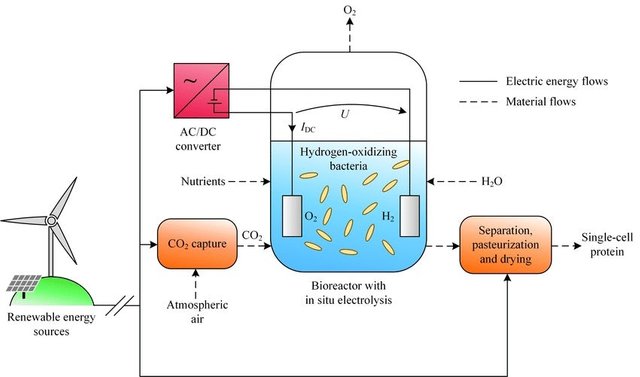Electric bioreactor farm
A team of researchers has produced a single protein cell that is sufficiently nourished to be a dinner, using a renewable energy system. All that is needed is electricity, water, carbon dioxide and microbes. The food was produced as part of the "Food of Electricity" project in collaboration with Lappeenranta University Technical research from Finland.
After exposing the raw materials to electrolysis in the bioreactor, a type of powder consisting of 50 percent protein and 25 percent carbohydrate - and the structure of the food can be changed by changing the microbes used in production.

Scientists make food from electricity and may solve this problem of hunger in the world
The next stage, according to Joha Pekka Petkanan, the scientist at the Finnish Technical Research Center, is improving the system because the bio-sized reactor takes about two weeks to produce one gram of protein. "We are focusing now To develop the following technologies: the concept of bioreactor, technology, and improve efficiency and process control »
He predicted that he needed a full decade before the system became more efficient. "Ten years may be a realistic time frame until we reach commercial capacity in terms of necessary legislation and process technology," he said.
A world without hunger
The potential impact of food production using electricity and raw materials widely available is unclear, and there are currently two main ways in which this achievement can contribute.
First, as a means of feeding hungry people in areas unsuitable for agricultural production, Petkanin said that in the future "this technology could be transferred to deserts and other areas facing famine, for example," providing a source of cheap and nutritious food for those in greatest need .
"It does not take a place where it can be cultivated," said Giro Ahula, a professor at the University of Lappeenranta Technology, in a press release. "There is enough temperature, humidity or a certain kind of soil."
Second, as a means of reducing global emissions, by reducing the demand for feedstocks and essential crops for their nutrition, the meat industry currently accounts for 14 to 18 per cent of the global GHG emissions, as well as the use of land areas that can be used for other purposes.
The food for electricity project can reduce the amount of unsustainable agriculture needed to fill our stomachs because it provides a smaller, cheaper and renewable way to get the nutrients we need. Another solution to this problem is farmed meat, or the cultivation of insects that produce less Waste and require less energy.
Sources: New Atlas, Phys.org, LUT